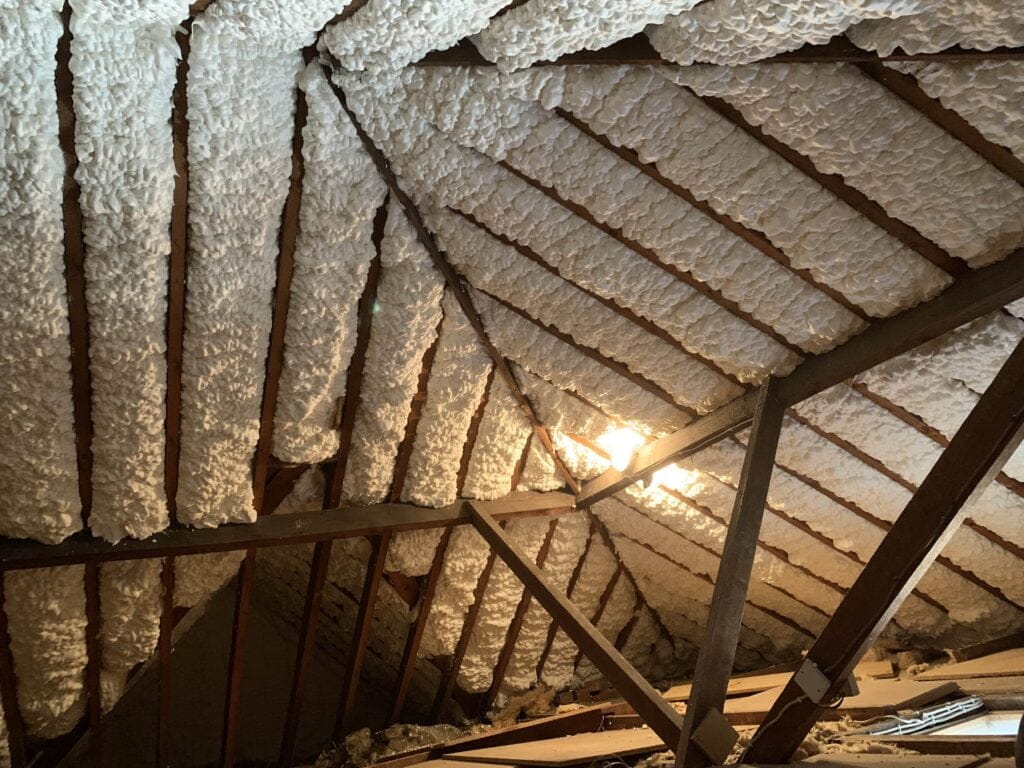The Environmental Impact of Spray Foam: Sustainability Considerations
The Environmental Impact of Spray Foam: Sustainability Considerations
Blog Article
Spray Foam: The Ultimate Option for Air Sealing and Insulation
Spray foam insulation has actually arised as a leading option for efficient air securing and thermal insulation, using a special combination of residential properties that set it apart from conventional methods. Understanding the complete range of its benefits, installation procedures, and comparisons with other insulation kinds is vital for making notified decisions.
What Is Spray Foam?
Spray foam is a functional insulation product that combines the concepts of air sealing and thermal resistance to enhance power effectiveness in structures. Made up mostly of polyurethane or other comparable substances, spray foam is applied as a fluid that broadens upon call with surfaces, creating a strong, continuous layer of insulation. This one-of-a-kind property enables it to fill voids, fractures, and gaps that standard insulation materials might overlook, giving an exceptional air seal.
There are 2 primary sorts of spray foam: open-cell and closed-cell. Open-cell spray foam is lighter and much more adaptable, using excellent noise absorption and a reduced R-value per inch - Spray Foam. On the other hand, closed-cell spray foam is denser, giving a higher R-value, dampness resistance, and added architectural integrity to developing components
The application procedure generally includes customized devices, making certain a seamless application that follows numerous substrates, including metal, concrete, and timber. This flexibility makes spray foam suitable for both new building and constructions and retrofitting existing structures. Its capability to produce an impermeable barrier substantially adds to reducing energy usage and boosting interior air quality, thus making it a favored selection among homeowners and contractors alike.
Benefits of Spray Foam Insulation
Among one of the most substantial benefits of spray foam insulation is its remarkable ability to produce a constant air barrier, which successfully lessens power loss. Unlike standard insulation products, spray foam broadens to fill up fractures and spaces, guaranteeing that air leakage is considerably minimized. This particular not only enhances energy efficiency but additionally brings about decrease energy expenses gradually.
Furthermore, spray foam insulation offers exceptional thermal resistance, contributing to a more stable interior environment. Its high R-value per inch permits for reliable insulation in restricted areas, making it perfect for attics, wall surfaces, and crawl areas. The moisture-resistant properties of spray foam aid stop mold and mold growth, advertising much healthier living conditions.
An additional vital benefit of spray foam insulation is its sound-dampening top qualities (Spray Foam). It efficiently reduces sound transmission between spaces, creating a quieter and a lot more comfortable home setting. The toughness of spray foam also attracts attention, as it does not sag or resolve in time, keeping its performance throughout its life-span
How Spray Foam Functions
Understanding exactly how spray foam insulation functions is vital for valuing its efficiency in air securing and thermal resistance. Spray foam insulation includes two key elements: isocyanate and polyol material. When these components are blended, they undertake a chemical reaction that triggers the product to broaden swiftly, creating a thick foam that fills cavities, fractures, and spaces.
As the foam increases, it abides by surfaces, developing an impermeable seal that significantly decreases air seepage. This characteristic makes spray foam insulation highly efficient at protecting against drafts and dampness infiltration, which can lead to energy loss and damage in time. Furthermore, the closed-cell variation of spray foam supplies premium thermal resistance due to its rigid structure, efficiently reducing warm transfer.
The distinct residential properties of spray foam permit it to adapt uneven surface areas, making certain thorough insurance coverage and a smooth barrier. Consequently, spray foam insulation not only enhances power performance yet additionally adds to boosted indoor air quality by decreasing the accumulation of allergens and toxins. Eventually, understanding the mechanics behind spray foam emphasizes its duty as a remarkable option for insulation and air sealing in both residential and business applications.
Setup Refine Introduction

Before setup, the room must be sufficiently cleansed and prepped, ensuring that surfaces are devoid of debris, wetness, and dirt. This action is critical because pollutants can jeopardize bond and total efficiency. When the location is prepared, the application entails blending both parts of the spray foam, which increases upon call and loads voids effectively.
Educated experts should carry out the installment, making use of customized tools to make sure consistent insurance coverage and optimal density. Security safety measures, consisting of putting on protective equipment and making certain proper air flow, are important during this process. After application, the foam typically cures promptly, creating a strong barrier that enhances power performance.
Contrasting Spray Foam to Conventional Insulation
When assessing insulation options, spray foam insulation stands like this out in contrast to standard products such as fiberglass and cellulose. One of the key benefits of spray foam pop over to this site is its exceptional air sealing capacities. Unlike fiberglass and cellulose, which can enable air infiltration, spray foam increases upon application, filling up holes and spaces to develop a closed seal. This results in boosted energy efficiency, as much less heated or cooled down air gets away the home, resulting in reduced utility costs.
Furthermore, spray foam provides a higher R-value per inch than typical insulation types, supplying more reliable thermal resistance in a thinner profile. This particular is particularly helpful in spaces with restricted cavity depth. In addition, spray foam is resistant to wetness and mold and mildew growth, which can be a considerable concern with cellulose and fiberglass, especially in moist environments.
However, spray foam insulation usually lugs a greater upfront expense than its standard equivalents. Homeowners should consider this first investment against long-lasting power financial savings and performance benefits. Ultimately, while both insulation types offer their objective, spray foam becomes an advanced option for contemporary insulation demands, specifically in regards to air securing and thermal efficiency.

Verdict
In recap, spray foam insulation stands for an extremely reliable option for accomplishing ideal air sealing and thermal resistance. Its distinct homes, including moisture resistance and sound dampening, make it ideal for different applications in both new constructions and retrofitting projects (Spray Foam). Although the initial prices might be higher compared to typical Read Full Report insulation products, the long-lasting benefits, such as substantial energy savings and boosted interior air high quality, justify the financial investment and highlight its value in modern-day structure practices.
Spray foam insulation has actually emerged as a leading option for effective air securing and thermal insulation, offering an one-of-a-kind combination of properties that establish it apart from traditional techniques.Spray foam is a versatile insulation product that combines the principles of air securing and thermal resistance to improve power efficiency in structures.When evaluating insulation choices, spray foam insulation stands out in contrast to conventional products such as fiberglass and cellulose. Inevitably, while both insulation types offer their objective, spray foam emerges as a much more innovative service for modern-day insulation needs, especially in terms of air securing and thermal performance.
In summary, spray foam insulation represents a very effective solution for accomplishing optimum air sealing and thermal resistance.
Report this page